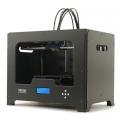Results 51 to 58 of 58
Thread: Print Quality issues (pictures)
-
10-13-2015, 05:38 AM #51
-
10-13-2015, 05:48 AM #52Engineer-in-Training

- Join Date
- Sep 2014
- Location
- Brummen, Netherlands
- Posts
- 265
Acetone smoothing has two uses. One is just to get a smooth surface (duh) which one may want for the looks (when I make a dark bronze painted and bluish patina'ed figurine for example).
The other use is technical as the smoothing makes a totally water- and gas- tight surface (which I need in my projects). Also, the smoothing process creates a totally homogenous surface layer. When applying pull-stresses, there are no inter-layer crevices (which will be there at any layer height, even 0.1mm) at the surface which can be initiating points for cracks to develop as the forces are the largest there. The smoothed ABS part thus has an enormously increased resistance to pull-stress cracking. Parts that endure torsion (one side press-stress, the other side pull-stress) are thus stronger.
-
10-13-2015, 07:31 AM #53Student

- Join Date
- Dec 2014
- Posts
- 42
how much thickness of your outside layer is chemically bonded due to the acetone bath? if it literally just the outside most layer I can't see that improving structural integrity any more than the fused plastic process of printing. I also think there is a use for chemically treating the surface for smoothness, but I'm not sure how much is added in terms of strength.
-
10-13-2015, 09:04 AM #54Engineer-in-Training

- Join Date
- Sep 2014
- Location
- Brummen, Netherlands
- Posts
- 265
I haven't measurred the thickness yet, but it depends on how long it was exposed. I also use the hot method, i.e. I boil the acetone (trust me to do it right, ie in a fume cabinet, I am a chemist by profession). My estimate is at least several tenth of a mm thick. My impression is that a good vapor bathing penetrates at least two perimeter layers into the part.
The smootihing does not enhance the overall strength of the part. The point is that by totally removing the surface inward curves between the layers, it is much harder to start a micro-crack that will grow out to a full crack. The rough pic illustrates this. When the pull force is applied (black arrows) the object will start to crack at a layer boudary (pointed to by the red arrow). The crack will rapidly move inwards until the part is in two. With a smoothed/fused surface it requires more force to make the start of a crack as there are no weak(-er) points in the surface area.
smoothed.jpg
-
10-13-2015, 09:27 AM #55
Ya you're not gonna get away from that rim that is closest to the build plate. You can put a .5 fillet on the bottom surface and that helps but even then you generally have to clean it up a little. I use a deburring tool and just cut off the excess.
I try not to do any acetone smoothing as the surface is too shiny for my preference most of the time.
-
10-13-2015, 01:56 PM #56Student

- Join Date
- Dec 2014
- Posts
- 42
As an update, I finally got it printing really nice, and then my extruder clogged and my roll of filament ran out, so I get to start this all over. lol.
I just pulled the extruder off the other side (its new and unused) and I'll take the clogged one home tonight so I can torch it and melt whatever is clogging it.
-
10-13-2015, 06:32 PM #57
-
10-14-2015, 05:23 AM #58
true :-)
You might also wnat to try pva for support or raft. Don't know how well abs sticks to it, but as what you are basically printing is solid gluestick - and abs sticks to that - should work.
And pva dissolves in water :-)
Once I get this bloody dual extrusion working - it's something I'll play with.






 Reply With Quote
Reply With Quote





Extruder not feeding during print,...
Yesterday, 01:59 AM in Tips, Tricks and Tech Help